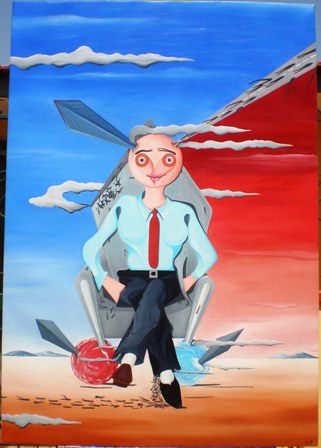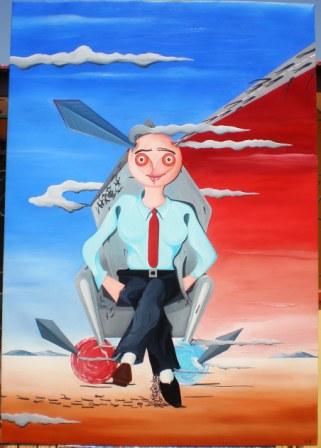
In primo piano, su uno scranno lapideo a forma di papalina, una figura indefinibile siede con le gambe accavallate. Lo scranno, la cui simbologia rimanda alla sacralità universale, si regge su due pianeti di tinte differenti e con nubi appena distinguibili. Uno rosso, simbolo di passione, l’altro celeste, simbolo di infinito. Da entrambi, attraverso due spacchi su cui si inserisce il trono, e da altrettanti squarci da cui fuoriescono due grattacieli, vengono fuori fumi pacati e sinuosi che percorrono in orizzontale la tela come una danza lugubre. Lo scranno, senza basi retrostanti, conferisce alla composizione un’instabilità che si trasmette all’osservatore provocando un moto di agitazione interiore.
La figura centrale, con due seni provocanti, distinti da un azzurrino sfumato e da due ombre laterali che ne evidenziano la consistenza, presenta nella parte inferiore del corpo una superficie mossa e tortuosa animata all’interno da sanguisughe laboriose che scarniscono la massa emaciandola, le quali, una volta finito il loro compito, a grappoli sgorgano dall’apertura del pantalone, unitamente a un fumo sfuggente che attraversa in lungo il corpo, come un prolungato serpente sinuoso.
Una cravatta rossa si insinua tra il seno procace.
Il viso, con gli occhi spalancati e le sopracciglia a forma di mignatte, con le gote gonfie, proietta esternamente dalla tela la composizione pittorica mostrandocela in tutta la sua narrazione visiva. Due visioni del modo si contrappongono e si distaccano per mezzo di una carreggiata, che diagonalmente penetra nella testa dell’uomo, percorsa da una instancabile colonna di sanguisughe diretta verso il centro della testa
Metafora dell’uomo moderno con le sue ambiguità culturali e religiose la tela ce lo mostra vittima della propria arroganza, della propria superbia e delle proprie certezze “fabbricate”, a volte, con imposizioni violente. Convinzioni che si sbriciolano sotto i colpi inferti dai propri simili che nella tela hanno le sembianze e delle sanguisughe e di fumi infestanti
Uno dei temi frequenti nei dipinti dell’autore è quello dei “colletti bianchi”, iconografia e simbolo dei nostri tempi, i quali nell’immaginario collettivo richiamano l’idea di affarismo e di corruzione, soprattutto alla luce degli avvenimenti degli ultimi decenni. Misteriosi nei gusti intellettuali e “sessuali”, attraversano il tempo della televisione segnando fortemente la memoria di un popolo. Gente “piccola” che si inerpica sugli scranni del potere per poter esercitare tutta la sua grandezza o tutta la sua mediocrità. Gente che muta la propria posizione morale nel momento in cui esercita un potere. Adulatori in pose artificiose per le telecamere, servi e frustrati socialmente, che ambiscono ad un esercizio di comando per instaurare anche un nepotismo da giarrettiera (un’invenzione clientelare moderna) che forse prima criticava. Nemmeno Uno che abbia più vergogna delle proprie azioni. Non a caso, c’è chi ha parlato della vergogna come termometro per misurare lo stato di salute di una democrazia e quindi di un popolo. Ed è costui che l’autore ha voluto raffigurare: un uomo “fagocitato” dai propri simili, con le sue caratteristiche “amorali” camuffate da un sorriso telegenico e un’ostentazione smodata. Sempre pronto a screditare tutti e a vantare le proprie imprese. Un uomo pronto a qualsiasi cosa pur di arrivare ad una posizione sociale tale da consentirgli di trattare tutti gli altri con arroganza e disprezzo. Un “carrierismo politico” che ha dato e che sta dando a molti di questa genia la possibilità di arricchirsi senza nessuno sforzo godendo di quei privilegi e di quelle immunità che gli garantiscano l’impunità da ogni reato.
In collezione privata
Sitting on the bench with leeches, hovering in the ambiguity of a magician
In the foreground, on a stone bench in the shape of skull cap, an indefinable figure sits with legs crossed. The chair, whose symbolism refers to the universal sacredness, is based on two planets of different colors and clouds barely distinguishable. A red, a symbol of passion, the other blue, a symbol of infinity. From both, through two slits on which you enter the throne, and as many insights from which emerge two skyscrapers, smoke come out calm and meandering that run horizontally in the canvas as a mournful dance. The chair, with no basis behind it, gives the composition of instability that is transmitted to the observer resulting in a surge of inner turmoil.
The central figure, with two provocative breasts, distinguished by a blue gradient and two side shadows that highlight the texture, the bottom surface of the body and move inside from leeches laborious winding animated mass that gaunt emaciated, the which, once finished their task, in bunches spring opening of the trousers, together with a smoke escaping through the body in long, winding like a long snake.
A red tie is insinuated between the breasts busty.
The face, with eyes wide open and eyebrows in the shape of leeches, with swollen cheeks, projecting outward from the canvas painter shows the composition in all its visual narrative. Two opposing visions of how and by posting a track, which diagonally penetrates the man’s head, covered by a relentless leeches column towards the center of the head
Metaphor of modern man with his ambiguous cultural and religious canvas shows him a victim of its arrogance, its pride and its certainties “manufactured”, sometimes with violent charges. Belief that crumble under the blows inflicted by their own similar to the canvas have the appearance and leeches and smoke weed
One of the frequent themes in the paintings is the author of “white collar”, iconography and symbol of our times, which in the collective recall the idea of profiteering and corruption, especially in light of the events of recent decades. Mysterious intellectual tastes and “sex” through the television time, strongly influenced the memory of a people. People “small” that winds up on the benches of the power to exercise all its grandeur and all its mediocrity. People who changed its moral position when they exercise power. Flatterers in artificial poses for the cameras, servants and socially frustrated, that they aspire to an exercise of command to establish a nepotism by Garter (modern invention patronage) that perhaps before criticizing. One that has even more ashamed of their actions. Not surprisingly, some spoke of shame as a thermometer to measure the health of a democracy and therefore a people. And it is this that the author wanted to portray a man “swallowed up” by their peers, with its characteristic “amoral” disguised as a telegenic smile and unbridled ostentation. Always ready to discredit and all boast their own businesses. A man ready to do anything to reach a social position which has enabled him to treat each other with arrogance and contempt. A “career politician” who has given and is giving to many of this ilk can get rich without any effort of those enjoying privileges and immunities as those guaranteeing the impunity of any crime.
